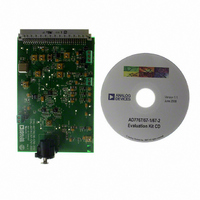EVAL-AD7767-1EDZ Analog Devices Inc, EVAL-AD7767-1EDZ Datasheet - Page 9

EVAL-AD7767-1EDZ
Manufacturer Part Number
EVAL-AD7767-1EDZ
Description
BOARD EVAL AD7767-1 64KSPS 111DB
Manufacturer
Analog Devices Inc
Specifications of EVAL-AD7767-1EDZ
Number Of Adc's
1
Number Of Bits
24
Sampling Rate (per Second)
64k
Data Interface
Serial
Inputs Per Adc
1 Differential
Input Range
±VREF
Power (typ) @ Conditions
10.5mW @ 64kSPS
Voltage Supply Source
Analog and Digital
Operating Temperature
-40°C ~ 105°C
Utilized Ic / Part
AD7767-1
Lead Free Status / RoHS Status
Lead free / RoHS Compliant
Preliminary Technical Data
USING THE EVALUATION SYSTEM
HARDWARE CONNECTIONS
With the hardware set up, you can now use the software to
control the EVAL-CED1Z and the AD7767/-1/-2 evaluation
board. To launch the software, from the Analog Devices menu
click on the AD7767 submenu, then click on the AD7767 icon.
Figure 8 displays the main window that opens.
Note: In the case where an Error message appears, click OK and
restart the application after checking the connection between
the adapter board and the USB port on the PC. Also, check that
the USB device is identified by the Device Manager as detailed
in the first time use of EVAL-CED1Z paragraph of Installing the
Software section.
USING THE SOFTWARE
Menu Bar
The menu bar consists of the following menus:
File – Open (Sample Data)
Opens previously saved sample data.
File – Save (Sample Data)
Saves the sample data this is currently displayed.
File – Open (Linearity Data)
1.
2.
3.
4.
5.
Apply power to the EVAL-CED1Z via +7V, 15W
power supply provided with the EVAL-CED1Z board.
At this stage, the green LED labeled ‘Power’ on the
EVAL-CED1Z should be lighting. This indicates that
the EVAL-CED1Z is receiving power The USB cable
can then be connected between the PC and the EVAL-
CED1Z.
Connect the EVAL-CEDZ and the evaluation board
together via the 96-way connector. The EVAL-
AD7767/-1/-2EDZ board is powered by a 7.5V and -
2.5V external supply.
Connect the USB cable between the PC and the
EVAL-CEDZ. A green LED positioned beside the USB
connector on the EVAL-CEDZ board will light
indicating that the USB connection has been
established.
The EVAL- AD7767EDZ will be detected - proceed
through any dialog boxes that may appear (use the
recommended options), to finalize the installation.
Start the EVAL- AD7767EDZ software.
Rev. PrB | Page 9 of 26
Opens previously saved linearity data.
File – Save (Linearity Data)
Saves the linearity data that is currently displayed.
File – Print Front Panel Picture
Prints the software screen displayed.
File – Save as Picture
Saves the displayed screen plot, i.e. waveform, histogram, FFT.
File – Exit
Closes the software.
Edit – Reinitialize Values to Default
Reinitializes all the controls on the front panel to their default
values.
Help – Open analog.com
Opens the www.analog.com website.
The software that controls the AD7767/-1/-2 evaluation board
through the EVAL-CED1Z has four main sections. As shown in
Figure 8. The top portion of the screen contains the menu bar.
The Part Information section is on the left hand side of the
screen. The Data Capture and Linearity tabs are in the centre
of the screen each of which contains a number of sub-tabs.
Part Information Tab
The Part Information tab allows the user to select a variety of
configurations
Just underneath the Part Information text is the drop down
menu to select the EVAL-CEDZ to operate with the AD7767/-
1/-2 evaluations board. This enables all the required signals that
are to be generated to run the AD7767/-1/-2 device.
Prior to taking samples from the AD7767/-1/-2 device the user
must provide a SYNC/PD pulse to the AD7767/-1/-2 device.
Press the Sync / Power Down button so that the AD7767/-1/-2
device is set-up to sample. This process must be followed each
time the EVAL-CEDZ is powered on. Following the SYNC/PD
samples can be acquired from the AD7767/-1/-2 device.
The AD7767/-1/-2 evaluation board runs using a 1.024MHz
MCLK. You can choose the sampling frequency up to this rate
by setting the MCLK frequency on the AD7767/-1/-2 front
panel. Please note though that the MCLK frequency supplied by
the EVAL-CEDZ board is not controlled by the MCLK setting
on the software front panel, it is set constant to 1.024 MHz.
However if an external MCLK signal is applied the MCLK
control on the front panel may be used so that all the frequency
calculations from the results of the samples are scaled correctly.
The frequency of the EVAL-AD7767EDZ crystal oscillator is
1MHz.
EVAL-AD7767/67-1/67-2


















